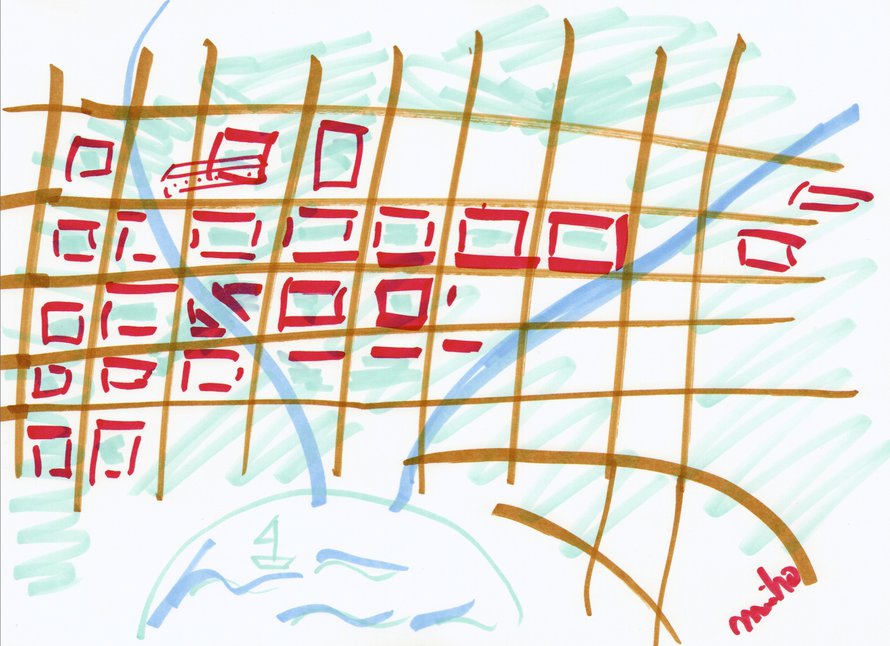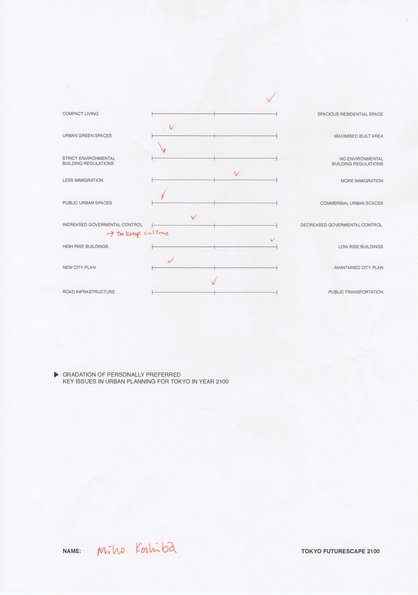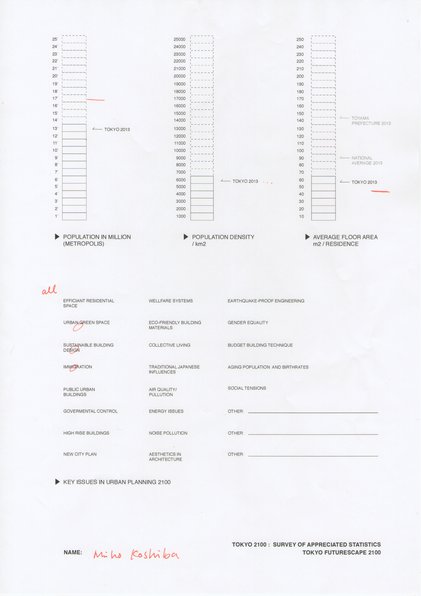Futurescape Tokyo is
a study in urban
fantasies and speculative
cartography. The project aims
to explore potential future
scenarios of the world's
largest megalopolis Tokyo,
which is expected to
shrink dramatically
during the next 86 years.
INTERVIEWS & MAPS
MIHO KOSHIBA
Miho Koshiba used to spend endless days in a huge anonymous Tokyo skyscraper, working as an investment banker. When the Lehman crisis hit, she started to re-evaluate her life choices and thought it all over again. Today, she is organizing the creative co-working space Midori.so in an abandoned house in Nakameguro. The three-story ivy-covered building is also home of the Mirai Institute, an independent think tank that Miho Koshiba recently launched together with her partners Teruo Kurosaki and Jonathan Yaffe. The plan is to create a platform for pursuing new and multicultural knowledge, in the quest to make the future a better one. As they say, "curiosity killed the cat, but not so many people".
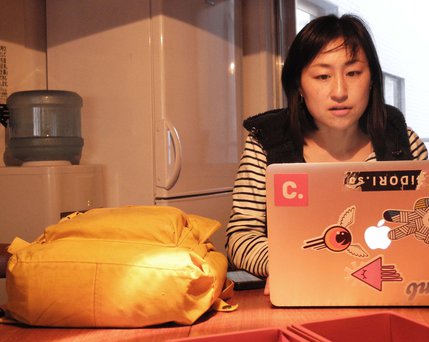
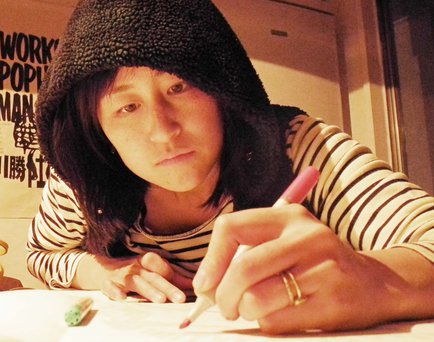
You seem to have a lot things going on. What are you up to right now?
I am starting up the Mirai Institute, which is the first independent think tank in Japan. We have not really started properly yet though. But right now we are organizing this co-working space called Midori.so, as an experiment of a future working style. More than 40 people work here now and we also have an art gallery. We try to connect people and create a community. Create things, share work, share thoughts and friends. That kind of stuff.
What does the name "Midori.so" stand for?
Midori means green in Japanese. Because when we first moved into this house it was completely covered by ivy. It was all green, until the autumn. Now it is winter but it will become green again. That is why we named it Midori.so. We also work with "green" initiatives, such as the solar panels upstairs. We just installed them, they provide us with heating and electricity.
The name is also a wink to the Tokiwa.so, the famous atelier that housed several of the most famous manga artists in the 1960s, before they got recognized by the big audience. Do you know Osamu Tezuka, the manga artist? He used to live and work there. Midori.so is a bit like the same concept. It is a place where entrepreneurs and creative individuals from different fields and different nationalities gather and create something new together. Many talents are growing from this house.
How would you describe Tokyo as a city today?
It is a "scrap & build" city. If a building gets old, they just tear it down and build a new one. In a way this can be interesting, because the city changes all the time. But on the other hand, it is sad when history, culture or really good architecture just disappear and become forgotten.
When we found this building, it had been abandoned for ten years and there were plenty of rubbish everywhere. So we cleaned it up, redecorated it, and put the furniture the way we liked it. But we did not change the exterior. We liked the green ivy-covered walls and wanted to keep it that way. So you could say that in a way, this house is the opposite of "scrap & build". We just renovated it and made it better.
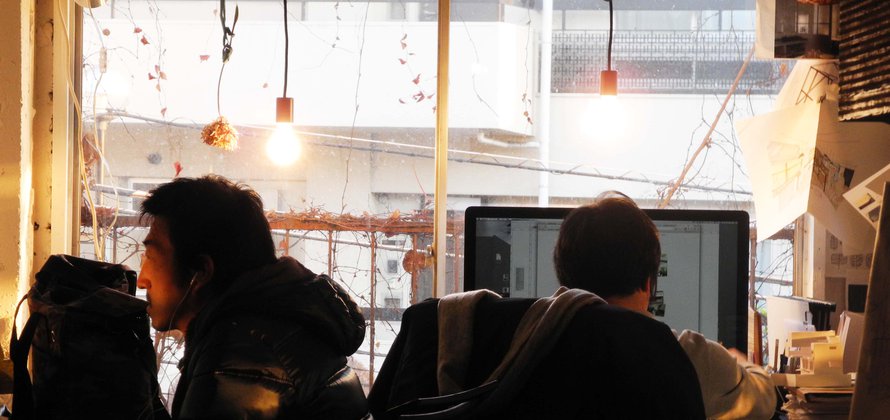

What role do you want the Midori.so and the Mirai Institute to play in the city?
You know, I used to work in an investment bank before. I went through the Lehman crisis and the following economic depression, and all this made me think about how Japanese companies seem incapable of forecasting and adapting to the future. Their only focus is to please their current costumers. And while costumer's trends are changing, the big companies do not notice. So a gap has occurred between the costumers and the producers. I realized that these kinds of issues will not be solved within the world of finances, so I decided to change my career. So this is what we try to do here in a way, forecasting the future.
But it also has to do with creating another kind of work style. As an investment banker I used to work from six in the morning until eleven at night, in a huge skyscraper building, with no windows open. I just really think there must be another way, in terms of the working environment and the work style.
How has your life changed since you quit your bank job?
It is quite flexible now. I can open the windows if it is hot. I can go out to the balcony to refresh my mind. That kind of stuff.
The prognosis is that the population of Tokyo will have shrunken to half, by the year 2100. Do you believe this will really happen?
I can not imagine that happening. While the population of the developed countries are shrinking, the total world population keeps growing and growing. We should be able to find some balance. Right now I can not see a balance between the development in Japan and the world wide phenomena.
Do you think immigration should be allowed in a higher scale?
Yes, I think an immigration policy should be made. I do not disagree to immigration of people from other countries. I think diversity is important and Japan is quite behind, in that aspect.
If you try to imagine Tokyo in 86 years, what do you think will be the biggest differences between now and year 2100?
I think a population decline might actually be a good thing. Today, the land lots in Tokyo are divided into tiny bits and people live in very tiny, cheap and poorly constructed houses. It is not great as it is now.
But on the other hand, the city might not change that much. It would be interesting if there was a complete change, but I do not think it will happen. If the policy makers continue with this kind of policy, then the city will not change drastically.

Do you think that people in Japan started to change their view on how urban living styles, after the big catastrophes in 2011?
Yes, I think so. A lot of share houses are being built, it is getting really popular. Big architect companies have started to build share houses. I think people want to stick together more. They realize they need the community. I guess it is more common abroad, but here students coming to Tokyo from their prefectures normally live by themselves in a tiny apartment. But nowadays share houses are getting really popular.
Do you think the view on energy have changed among people?
I think so. People are blaming the Tokyo Electricity Power Company for the nuclear crisis but the thing is, we are all pretty much dependent to the company, and we are all dependent on the nuclear power. Now suddenly people have changed their minds and blame the TEPC. I think that is kind of nonsense if you do not do anything about it or change your habits. We should really think of alternatives.
TOKYO'S FUTURESCAPE ACCORDING TO MIHO
Tokyo 2100 has a sea side, and a river, and quite a lot of green areas. The roads on the map show how the city is divided in blocks, like it is in Kyoto. There are low rise buildings, and inside each block, there are a lot of greens..
Miho Koshiba
